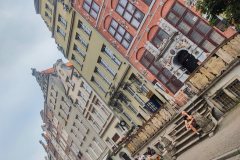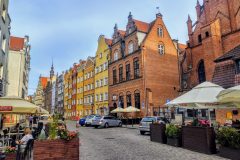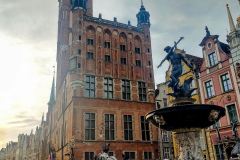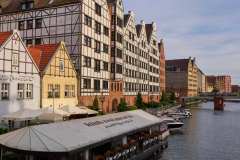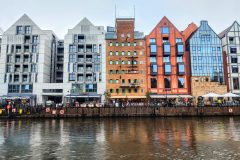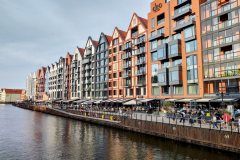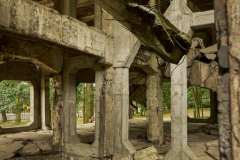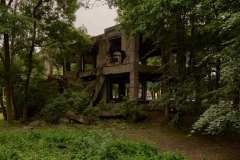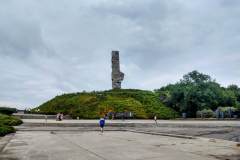
10 top places you cannot miss in Gdańsk
The city with rich history and amazing architecture. The city, which was almost fully wiped out during the Second World war. The city, which attracts almost 3 million tourists yearly. Gdańsk is the most beautiful city on the whole polish seaside. It belongs to the Tri-City metropolitan area, including Gdynia and Sopot. Gdańsk however is the biggest among those 3. Starówka, the Motława river embankment, and the singularity of this city intrigue travelers from around the world.
HOW LONG?
One day is enough to fall in love with Gdańsk. However, for the best travel experience extend the visit to two or three days. You get to know the old city, visit the most important and the best museum of the second World War. You’ll also have enough time to see Westerplatte. A place, where the Second World War started back in 1939.
BEFORE STARTING THE CITY TOUR
Gdańsk is a city with over one hundred years of tradition, it’s the marine capital of Poland and one of the largest ports on the Baltic Sea. 997 was the date considered to be the beginning of the city’s history. Not long after Gdańsk joined the Hanseatic League allowing it a perfect flow and management of trade between the Baltic sea and western Europe. From the XIV century, Gdańsk changed its possessors from the Teutonic Knights through Prussians to German Empire, gaining its freedom from time to time. Gdańsk is also associated with the beginning of the Second World, which happened in Westerplatte in September 1939. The time between 1939 and 1945 was memorable for its inhabitants. People had to witness the death of their loved ones and the demolition of their dear city. Almost 90 % of the old town has been razed during that time. I’m happy after WW2 it was agreed to rebuild the city, with the main focus on the historic sites, we can admire today.
Let’s now focus on the places you definitely have to see, moving next to a less known one.

OLD TOWN
Amazing colorful facades resembling the ones in Nordic cities decorate the main streets of Gdańsk. It’s Długa and the Royal Route, which are the liveliest and busiest. Both sides of the streets are dotted with cafes or restaurants, unfortunately, they’re also overcrowded. When you stroll down the Starówsla, you get the impression that the surrounding buildings are thousand years old. However, the reality is quite different – most of them were rebuilt after World War II.

NEPTUNE’S FOUNTAIN
Neptune’s Fountain is so recognizable, it became a famous picture spot. If you don’t have one it’s like you’ve never been to Gdańsk. No wonder the queue is that long. The sculpture is made of bronze by the sculptor Abraham van den Blocke back in 1615. The sculpture shows Neptune bowing his head slightly as a sign of deference. On the basin beneath him are ornamental fish and cherubs.

NEPTUNE’S FOUNTAIN
MOTŁAWA RIVER EMBANKEMENT
Everyone finally finds their way here and is more than satisfied with the outcome. Again, the eye-catching bright buildings, famous Sołdek ship with a museum inside, or a must-see historic crane. All to be found there. Before the port was relocated to the mouth of the Dead Vistula River in the XIXth century, this quay was where all of Gdańsk’s loading and unloading took place.

CRANE ZURAW
One building that stands out is the crane (Zuraw). This crane has been used hundreds of years ago to load cargo into ships. The hulking mass is a symbol of Gdansk’s days as an important trading city. Due to reconstruction (2021), visiting is postponed. The characteristic point, the Gdańsk Crane on Motlawa’s Long Embankment dates back to the 14th century. This piece of machinery harks back to the time when Gdańsk was in the Hanseatic League, and could load or unload four tons of cargo, lifting it to a height of 11 meters. The crane was in use up to the 1800s. Now it’s maintained by the National Maritime Museum.
EUROPEJSKIE CENTRUM SOLIDARNOŚCI
On the official webpage, you may read: “The ECS is a state-of-the-art cultural institution that honors our greatest civic success—the victorious Solidarity movement. It is a museum that commemorates the revolution of Solidarity and the fall of communism in Europe, but it is also an educational, research, and academic center, an archive, a library, and a multimedia library. Last but not least, it is a public meeting space for citizens who feel responsible for the development of democracy: a place where solidarity and citizenship are put into practice.”
It’s a place we didn’t make it to, but also because kids (3 and 6 years old) would simply be bored. This time we skipped it, but hopefully next time we get the time to see it. It looked pretty interesting from the outside.
WESTERPLATTE
Here you’ll set foot on ground zero for the Second World War. A Polish military transit depot was installed here in the 1920s by permission from the League of Nations and was seen by the Germans as a vital first domino for their invasion. After the war one of the guardhouses was restored and turned into a museum, while the others have been left in ruins. At the highest point of Westerplatte, there’s a memorial to the “Coast Defenders”, assembled in 1966 and made of 236 granite blocks rising to 25 meters. You may count to spend here at least 2 hours. Take bus 606 or 106 to Westerplatte bus stop or park your car for 6 PLN for an hour.

PIER AT BREZNO BEACH
After a day or two on the streets of Gdańsk you may be ready to walk by the sea or rest up a bit at the beach. The closest one is on the waterfront of the Jelitkowo District to the northwest of the Old Town. The shore is wide, within close proximity you may find some souvenir shops, cafes, or restaurants. Behind the foreshore, there’s a paved cycling path if you’d like to break even further from the city. You can get to Jelitkowo via trams 3 and 5.

SOBIESZEWO ISLAND
This is a quiet place overlooking the bay of Gdańsk. It’s said that the wide, sandy beaches there are the most beautiful bathing areas on the Polish coast. It’s a green paradise. Bikers, hikers, photographers -all can find their way here. Sobieszewo Island is a bit further, it’s 15 kilometers away from the city, but this is exactly why locals come here. It’s not super busy like the city beach.
ZASPA DISTRICT
Zaspa is a local neighbourhood with the largest outdoor art gallery in Europe. Wall murals are all over the district of Zaspa. You may visit the website to get the map or order a tour with a local guide. What an interesting art exhibition, and it may be for free.
FALOWIEC
The longest Polish Falowiec (wave block) is located in the Przymorze Wielkie estate in Gdańsk at Obrońców Wybrzeża Street.It was built in the years 1970-1973. It’s 860 meters long and 32 meters high. Can you imagine 1792 apartments in one building accommodating around 4 thousand people?
FOOD
Bar Mleczny Neptun. This is a milk bar, a Polish “cafeteria.” These milk bars popped everywhere after World War I, as a way for the Polish people to get nourishing meals at cheap prices. Now, these are rare to find in city centers, although a few still remain. If you want to try a cheap, local meal or want to take part in a Polish tradition, Bar Neptun is one of the best milk bars in Gdansk.
Don’t miss the famous Piwna street (Beer street) for the best bar experience.
One of the traditional Polish meals are pierogi. And the best one in the whole Gdańska are in Mandu (Gdańsk-Oliwa, ul. Kaprów 19D i Gdańsk-Śródmieście, ul. Elżbietańska 4/8). They serve them sweet, salty, vegan, all handmade and prepared with love.
The best ice-creams in Gdańsk are in the Miś. (Podwale Staromiejskie 62/68). It’s famous ice cream shop with a wide variety. The ice-creams are being made here for five decades already.
PRACTICAL
Gdańsk is huge. If you want to go outside of the Old town, use public transport. If you buy a 24-hour ticket it’s cheaper than regular ones. Use the app or site jakdojade.pl for a better understanding of the transportation system.
Parking in the inner city costs around 6 PLN per hour, which is around 2 EUR.
The accommodation in Gdańsk is pretty expensive. Book your room way in advance if you plan your trip to the Polish seaside during the summer season. If you want to avoid crowds, choose May or September/October.
Other activities to do in Gdansk:

Sopot for a day
You May Also Like

Lodz, Poland- 4 awesome ways to see it.
November 20, 2022
Forest Educational Path in Brno Sobesice
December 12, 2020

